What Is an Outstanding Deposit?

Organizing all your finances for your business isn’t always an easy thing to do. There’s lots to worry about and it takes time to do your accounting processes accurately. And if you regularly sell a good or service to your customers, you might expect to see that money in your account right away.
However, sometimes it just doesn’t work out that way. So what can you do to help keep your business’s finances on track? You can reconcile your bank account statement and your books. But even then, you might see that your account balances and books don’t match exactly.
This might mean you have an outstanding deposit. Here is everything that you need to know about outstanding deposits.
Here’s What We’ll Cover:
Understanding What Is an Outstanding Deposit?
Understanding What Is an Outstanding Deposit?
Think about how you take payment from your customers for the goods or services that you provide. For example, some payments might be made in cash or some customers might pay by check. But what happens if your business’s receipts show up in your general ledger accounts, but not in your bank statement?
When this happens it’s considered to be an outstanding deposit. It can also be commonly known as a deposit in transit or cash in transit. If you perform bank reconciliation, an outstanding deposit gets listed as a reconciling item.

An outstanding deposit doesn’t typically last for longer than a day or two. So if you’re preparing a bank reconciliation you will likely only see a few, if any.
Try looking at it from an accounting perspective. An outstanding deposit is any item that’s included on your profit and loss account, but not on your bank statement. Simply put, when you have a customer send money from point A and it hasn’t reached point B, it’s cash in transit.
Outstanding Deposit Examples
One of the easiest ways to think about an outstanding deposit is to think about a check. When a customer gives you a check to make payment for something, do you usually grab it and immediately run to the bank? Not likely.
You would instead wait until the end of the day, week or month, and then deposit several checks at once. It’s important to recognize that even though your bank statement won’t show the check amount, you still record the income in your books. The check then stays outstanding until you finally deposit it at the bank.
Let’s say that a customer writes you a check for $100 on 29 March. You’re going to record that check amount in your books. But, you don’t deposit the check into your bank account until 12 April. When you reconcile your books for the month of March, that $100 check won’t be included in your March bank statement.

Key Takeaways
As a small business owner, there’s lots for you to worry about, especially when it comes to your accounting processes. You need to make sure that your books are done correctly and you maintain accurate financial records. Knowing and understanding all your outstanding deposits can help avoid any accounting issues.
The good news is that reconciling your bank statements can help you stay on track. Outstanding deposits can help you balance your accounts. Plus, doing this can allow you to gain insights into and measure things like profitability and cash flow.
Did you enjoy reading this guide? Head over to our resource hub for more great content!
RELATED ARTICLES

 Production Volume Variance: Definition, Formula & Example
Production Volume Variance: Definition, Formula & Example What Is Off-Balance Sheet Financing? Definition & Example
What Is Off-Balance Sheet Financing? Definition & Example What Are Retained Earnings? Definition, Examples & Calculation
What Are Retained Earnings? Definition, Examples & Calculation Cost Method: An Accounting Guide
Cost Method: An Accounting Guide What Is TTM (Trailing Twelve Months) in Finance?
What Is TTM (Trailing Twelve Months) in Finance? Average Collection Period: Overview, Formula & Example
Average Collection Period: Overview, Formula & Example